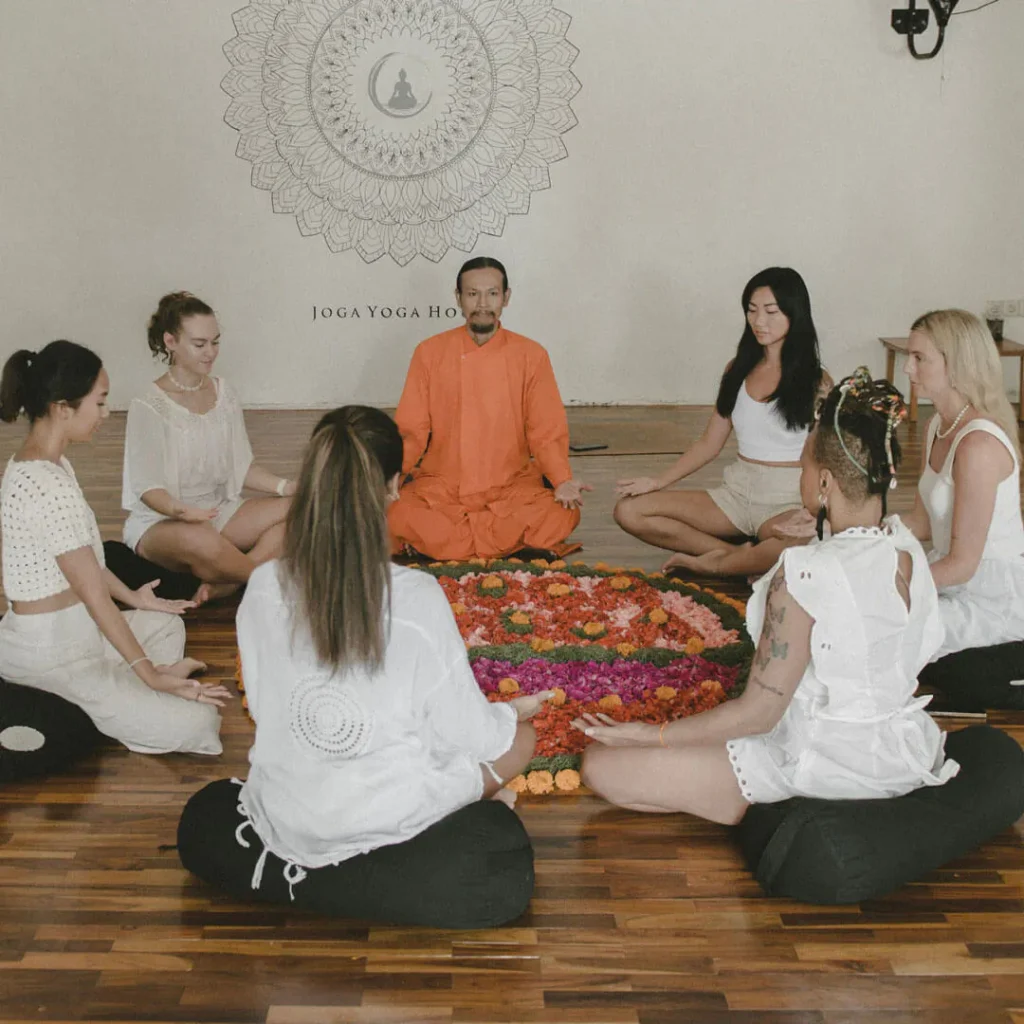Introduction: Why Rishikesh Is Unique
Rishikesh is a special city in northern India. It sits along the banks of the holy Ganga River, right at the foot of the beautiful Himalayan mountains. People from all around the world come here to find peace, do yoga, meditate, and explore nature.
Rishikesh is often called the “Yoga Capital of the World.” Many big yoga festivals, teacher trainings, and spiritual retreats happen here every year. Even UNESCO and other global groups recognize Rishikesh as one of the most important places for yoga and wellness.
But it’s not just for yoga! Rishikesh is also famous for adventure sports, beautiful scenery, and ancient temples. Whether you’re a spiritual seeker, an outdoor lover, or just someone who wants a fresh start, Rishikesh offers something magical for everyone—locals and visitors alike.
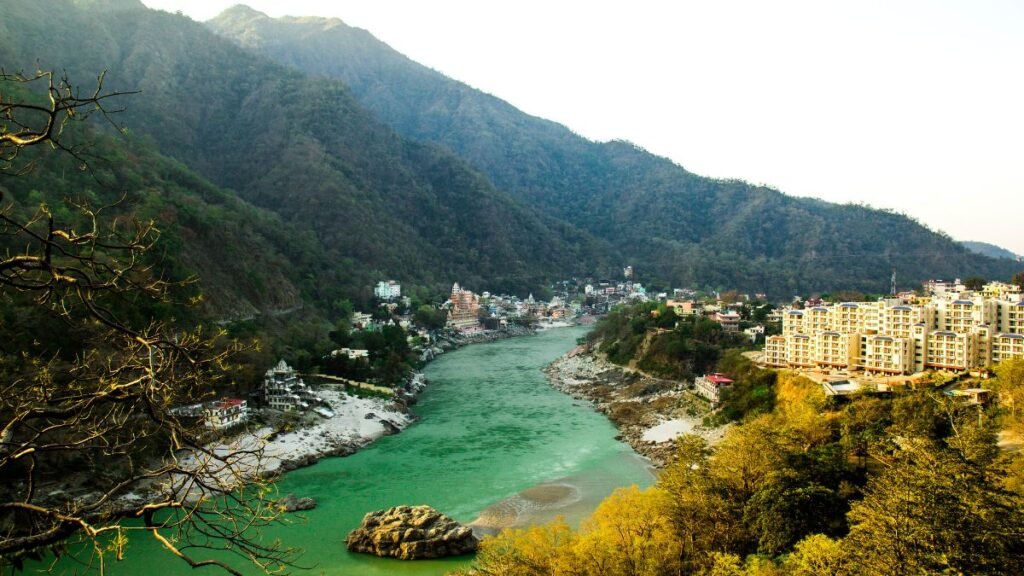
Where Is Rishikesh in India?
Rishikesh is in the state of Uttarakhand, in northern India. You’ll find it at the start of the Himalayan mountains, right where the Ganga River leaves the mountains and flows into the plains.
If you look at a map, Rishikesh is about 240 kilometers (150 miles) north of New Delhi, India’s capital city. It’s also close to Haridwar, another famous holy city. You can reach Rishikesh by train, road, or even by airplane.
- By Train: There are regular trains to Haridwar. From Haridwar, Rishikesh is just a short car or bus ride away (about 20 km).
- By Road: Buses and taxis connect Rishikesh to major cities like Delhi, Haridwar, and Dehradun.
- By Air: The nearest airport is Jolly Grant Airport in Dehradun, which is about 35 km away. From there, you can take a taxi or bus to Rishikesh.
Nearby, you’ll also find cities like Haridwar, Dehradun, and Mussoorie. All these places are known for their natural beauty and spiritual energy.
The History and Spiritual Significance of Rishikesh
Rishikesh is an ancient city, filled with stories and legends. According to Hindu mythology, the great river Ganga flows through Rishikesh, bringing spiritual energy from the Himalayas. Many sages and saints have meditated here for thousands of years, seeking wisdom and enlightenment.
The city is home to many famous temples and ghats (riverfront steps). Triveni Ghat is where people gather every evening for the Ganga Aarti, a magical ceremony with chanting, fire, and music. Parmarth Niketan is a large ashram that welcomes visitors from all over the world. Other important sites include Neelkanth Mahadev Temple, dedicated to Lord Shiva, and Bharat Mandir, one of the oldest temples in Rishikesh.
Rishikesh has always been a place for yoga and meditation. Ancient scriptures say this is where yoga was practiced and taught by the earliest yogis. Today, thousands of people come here to learn and practice yoga, making Rishikesh a living center of spiritual tradition.
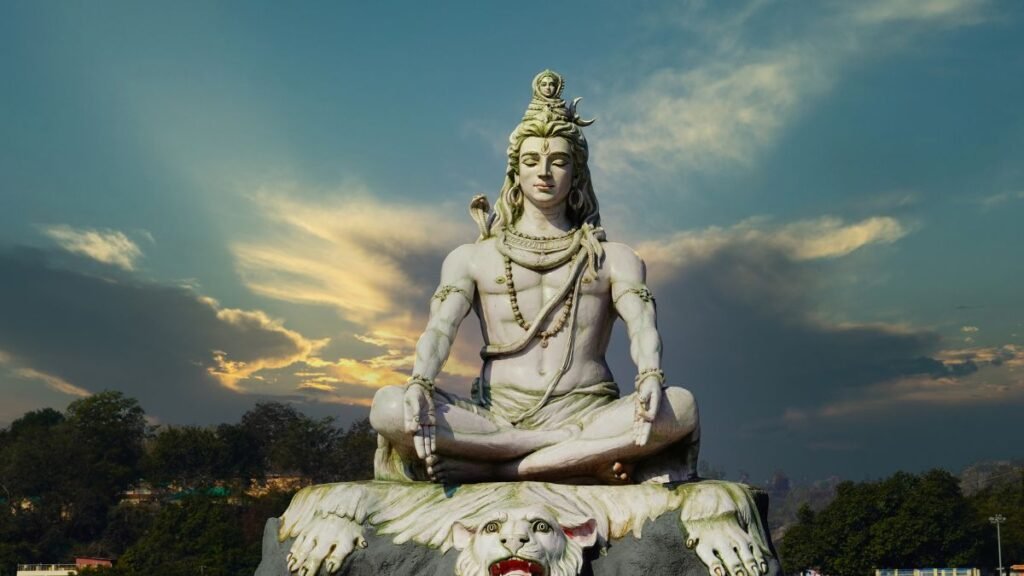
Yoga in Rishikesh: Why It’s the Global Capital
Rishikesh is famous all over the world as the top place to learn and practice yoga. There are hundreds of yoga schools, ashrams (spiritual centers), and retreats. Many of these ashrams have been teaching yoga, meditation, and philosophy for decades—even centuries!
People come to Rishikesh from every continent to become yoga teachers, join special courses, or just practice with experts. Well-known yoga centers like Parmarth Niketan, Sivananda Ashram, and the Yoga Niketan Ashram offer programs for all levels.
If you want to become a certified yoga teacher, Rishikesh has many Yoga Alliance–approved teacher training programs. These trainings attract students who want to learn yoga’s true roots, directly from its source.
Every evening, you can see the Ganga Aarti at Triveni Ghat or Parmarth Niketan. It’s a powerful ritual where people sing, pray, and offer light to the river. This daily ceremony is a highlight for visitors, bringing everyone together for peace and gratitude.
Adventure & Wellness Activities
Rishikesh isn’t just for yoga—there’s a lot of adventure and relaxation too! The fast-flowing Ganga River makes Rishikesh the most popular spot in India for white water rafting. Many people also come for bungee jumping, ziplining, and trekking in the nearby forests and mountains.
If you prefer nature walks, there are beautiful trails along the river and through the hills. You might spot monkeys, birds, or even peacocks.
For wellness, Rishikesh has lots of Ayurveda centers, massage clinics, and wellness retreats. You can get traditional therapies, healthy meals, and relaxing spa treatments.
The best time for adventure sports in Rishikesh is from October to June, when the weather is pleasant and the river is just right for rafting.
Places to Visit and Top Attractions
There’s so much to see in Rishikesh! Here are some must-visit spots:
- Laxman Jhula and Ram Jhula: These two famous suspension bridges cross the Ganga and are lined with temples, shops, and cafes. Walking across gives amazing views of the river and hills.
- The Beatles Ashram (Chaurasi Kutia): This old ashram is where the Beatles stayed in the 1960s. Today, you can explore its art-covered walls and peaceful gardens.
- Neer Garh Waterfall: A short trek from town leads to this beautiful, refreshing waterfall.
- Triveni Ghat: The main ghat for evening Ganga Aarti, it’s the heart of spiritual life in Rishikesh.
- Parmarth Niketan Ashram: One of the largest ashrams, open for yoga, meditation, and cultural events.
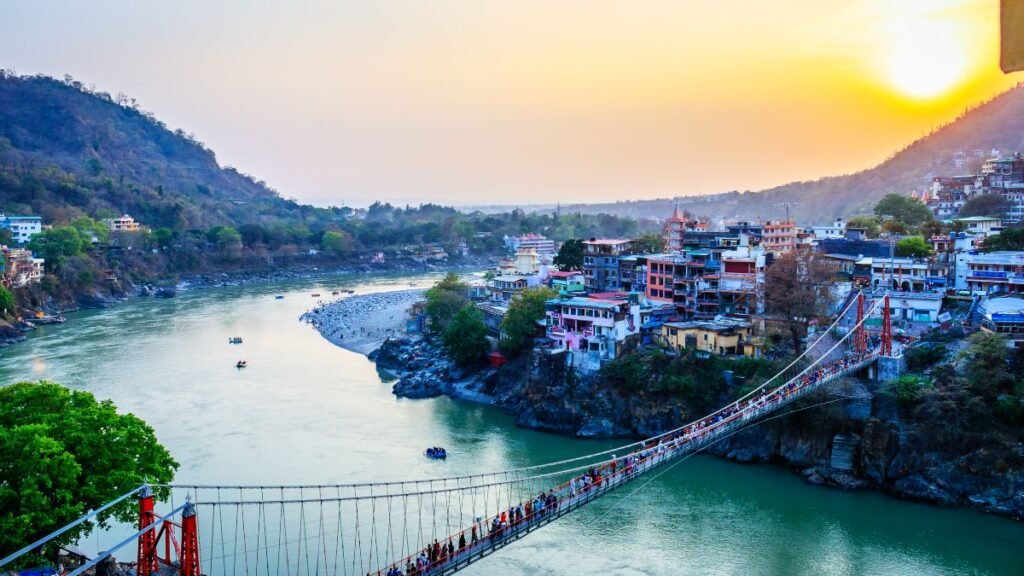
Other sacred sites and cultural spots include Bharat Mandir, Swarg Ashram, and the busy local markets. If you look a little deeper, you’ll find hidden gems like quiet riverside spots, tiny temples, and peaceful trails away from the crowds.
Staying in Rishikesh
Rishikesh has many different places to stay, for all kinds of travelers and budgets. You can sleep in a simple ashram, enjoy a peaceful yoga retreat, book a cozy guesthouse, or stay in a comfortable hotel.
Ashrams are spiritual centers where you can join yoga classes, meditation, and follow a daily routine. Many ashrams are very affordable and include meals and yoga sessions. The vibe is peaceful and simple—perfect if you want to connect with your inner self.
Yoga retreats offer programs that include accommodation, food, yoga classes, and sometimes wellness treatments. These are a bit more private and often feel like a small community.
Hotels and guesthouses range from basic to luxurious. You’ll find places with air-conditioning, Wi-Fi, and river views. Prices go from just a few dollars per night in a dorm or guesthouse, up to $50 or more for a nice hotel room.
If you are a solo traveler or a digital nomad, Rishikesh is friendly and safe. There are lots of co-working cafes with Wi-Fi and many people traveling alone. Just remember to be respectful in sacred areas, and you’ll easily make new friends in yoga classes or community events.
Food, Cafes & Healthy Living
Rishikesh is known for its delicious vegetarian and vegan food. Because it’s a holy city, most restaurants and cafes do not serve meat or alcohol. You’ll find fresh fruit juices, smoothie bowls, Indian thalis (set meals), and creative salads everywhere.
Popular spots to eat include riverside cafes with views of the Ganga, open-air market stalls selling street snacks, and ashram dining halls serving simple but nourishing meals.
Many cafes offer herbal teas, gluten-free desserts, and special “wellness menus” for health-conscious visitors. If you’re following a special diet, just ask—the staff are usually happy to help.
If you want to eat like a local, try dal (lentil soup), chapati (flatbread), aloo gobi (potato and cauliflower), and chai (spiced tea).
Weather in Rishikesh: What to Expect Year-Round
Rishikesh has different weather throughout the year. Here’s a quick guide to help you plan your trip:
- October to March: Cool and pleasant (best time to visit for yoga and sightseeing)
- April to June: Warm and sunny (great for river rafting and outdoor activities)
- July to September: Rainy season (monsoon); lush and green, but some activities may close due to rain
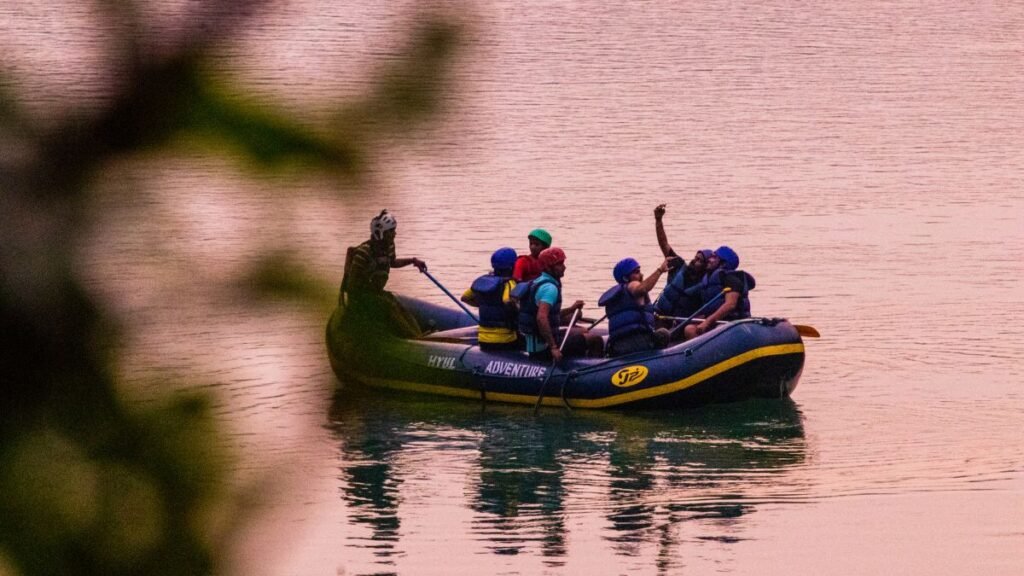
Most yoga teacher trainings and retreats happen in the cooler months (October to March), when the weather is comfortable and festivals like Diwali and Holi bring extra excitement.
Packing Tips:
Bring light cotton clothes, a jacket or sweater for cool evenings, a raincoat or umbrella in the monsoon, and comfortable walking shoes or sandals. Don’t forget a reusable water bottle, sunblock, and a hat for sunny days. If you plan to visit temples or ashrams, pack modest clothes that cover your shoulders and knees.

Practical Tips for Travelers
How to get around Rishikesh:
Most people get around Rishikesh by walking, as the main areas are close together. Rickshaws are cheap and easy for longer trips. There are also local buses and taxis for visiting places outside town.
Internet, ATMs, and emergency info:
Many cafes and hotels have free Wi-Fi. ATMs are available in the town center. For emergencies, there are local hospitals, police stations, and pharmacies. Save the address and contact info for your hotel and embassy, just in case.
Cultural etiquette for international visitors:
Always take off your shoes before entering someone’s home or a sacred place. Avoid public displays of affection. Use your right hand to give or receive things. Be patient—life in Rishikesh moves at a slower pace.
Rishikesh Now and Then: Modern Changes & Timeless Spirit
Rishikesh is changing fast. Yoga tourism brings people from all over the world, and more digital nomads are living here to enjoy the peaceful life and fast Wi-Fi in local cafes. There are new eco-friendly hotels, recycling programs, and community clean-ups to help the environment.
But even as Rishikesh grows, it keeps its ancient spirit. Daily prayers, festivals, and temple rituals still fill the streets with color and music. Local people are proud to share their traditions and help travelers discover the real meaning of yoga and kindness.
Many hope that Rishikesh will keep balancing new comforts with its deep roots in yoga and nature.
Conclusion & Resources
Rishikesh is a place where ancient traditions and modern adventure come together. Whether you want to practice yoga, explore nature, meet people from around the world, or just find some peace, Rishikesh has something for everyone. It’s more than just a city—it’s an experience you’ll never forget.
Further reading and resources:
Ready to plan your journey or yoga retreat in Rishikesh?
Start researching yoga courses, book your stay, and get ready for an adventure in the heart of India’s yoga capital!

Frequently Asked Questions About Rishikesh
Is Rishikesh Safe for Tourists?
Yes, Rishikesh is considered a safe place for travelers, including solo visitors. People are friendly, and there is a strong spiritual vibe in the city. Just take normal precautions, like keeping valuables secure and being careful at night.
What Is the Dress Code for Temples and Ashrams?
Dress modestly when visiting temples or ashrams in Rishikesh. Wear clothing that covers your shoulders and knees. Light, loose pants and t-shirts are ideal. Always remove your shoes before entering any sacred place.
Can You Swim in the Ganga?
The Ganga River is sacred, and many people take a dip for religious reasons. Some places are safe for swimming, but always check with locals or signs before entering the water. The current can be very strong, and not all areas are safe for swimming.
How Can Visitors Respect Local Customs?
- Be quiet and respectful in temples and during prayers.
- Ask before taking photos of people or ceremonies.
- Do not bring meat, alcohol, or drugs to holy places.
- Smile, greet people with “Namaste,” and enjoy learning about local traditions.
When Is the Best Time to Visit Rishikesh?
The best time to visit Rishikesh is from October to March when the weather is cool and pleasant. These months are ideal for yoga courses, sightseeing, and adventure sports. The summer months (April to June) are warmer, and the monsoon season (July to September) brings heavy rain and lush green scenery.
How Do You Get to Rishikesh?
You can reach Rishikesh by:
- Air: The nearest airport is Jolly Grant Airport in Dehradun, about 35 km away. Taxis and buses are available from the airport to Rishikesh.
- Train: The closest major railway station is in Haridwar, 20 km away. From Haridwar, you can take a taxi or local bus.
- Road: Buses, taxis, and private cars run regularly from cities like Delhi, Haridwar, and Dehradun.
What Are the Top Things to Do in Rishikesh?
- Practice yoga and meditation at world-famous ashrams.
- Watch or join the Ganga Aarti ceremony at Triveni Ghat.
- Walk across Laxman Jhula and Ram Jhula bridges.
- Try river rafting, bungee jumping, or trekking.
- Visit The Beatles Ashram, waterfalls, and local temples.
- Enjoy vegetarian cafes and markets.
Are There ATM Machines and Internet in Rishikesh?
Yes, there are plenty of ATMs in the town center. Most hotels, cafes, and guesthouses offer free Wi-Fi. Internet speed is usually good enough for travelers and digital nomads, but may slow down during festivals or peak seasons.
Is Alcohol or Meat Allowed in Rishikesh?
No, Rishikesh is a sacred city and most places do not serve alcohol or meat. Almost all restaurants and cafes are vegetarian or vegan, and selling alcohol is restricted by law.
What Language Do People Speak in Rishikesh?
The main language is Hindi, but English is widely spoken in hotels, ashrams, cafes, and by most tour operators. You will have no trouble getting around or asking for help in English.





